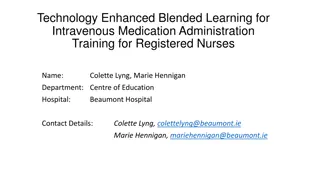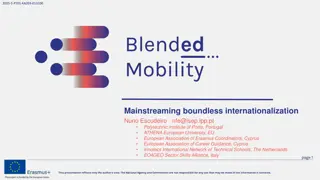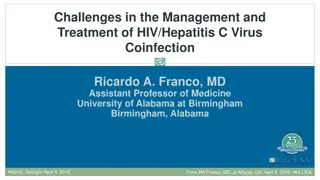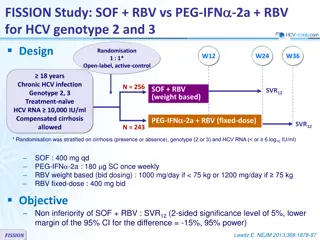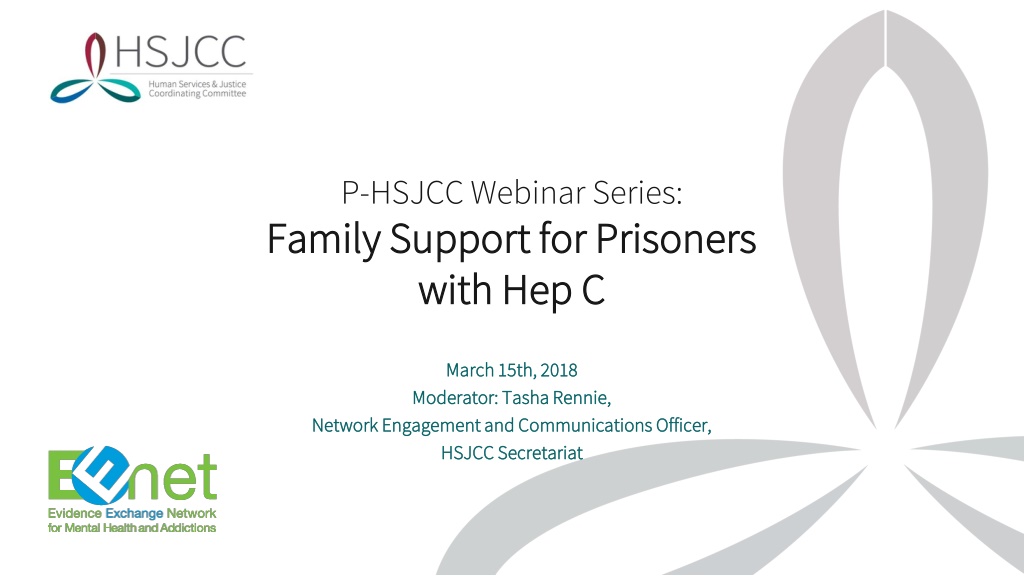
Support for Prisoners with Hep C - Webinar Series Overview
Explore family support for prisoners with Hep C in this informative webinar led by Lindsay Jennings, Provincial Hep C Program Coordinator from the Prisoners with HIV/AIDS Support Action Network (PASAN). Learn about PASAN's initiatives, advocacy, and support services provided to the prisoner population in Ontario. Gain insights into promoting healthcare and addressing public health issues within the prison system.
Download Presentation

Please find below an Image/Link to download the presentation.
The content on the website is provided AS IS for your information and personal use only. It may not be sold, licensed, or shared on other websites without obtaining consent from the author. If you encounter any issues during the download, it is possible that the publisher has removed the file from their server.
You are allowed to download the files provided on this website for personal or commercial use, subject to the condition that they are used lawfully. All files are the property of their respective owners.
The content on the website is provided AS IS for your information and personal use only. It may not be sold, licensed, or shared on other websites without obtaining consent from the author.
E N D
Presentation Transcript
P-HSJCC Webinar Series: Family Support for Prisoners Family Support for Prisoners with Hep C with Hep C March 15th, 2018 March 15th, 2018 Moderator: Tasha Rennie, Moderator: Tasha Rennie, Network Engagement and Communications Officer, Network Engagement and Communications Officer, HSJCC Secretariat HSJCC Secretariat
HSJCC Webinar HSJCC Webinar We will have a Q&A period at the end of our webinar. To ask a question, please type your question in the chat box. This webinar will be recorded. The recording and power- point presentation will be emailed to you following the webinar. Please complete the brief evaluation survey following the webinar.
About the HSJCC Network About the HSJCC Network HSJCC Network is comprised of: 42 Local HSJCCs 42 Local HSJCCs 14 Regional HSJCCs 14 Regional HSJCCs Provincial HSJCC Provincial HSJCC Each HSJCC is a voluntary collaboration between health and social service organizations, community mental health and addictions organizations and partners from the justice sector including crown attorneys, judges, police services and correctional service providers.
Presenter Presenter Lindsay Jennings, Lindsay Jennings, Provincial Hep C Program Coordinator, Prisoners with HIV/AIDS Support Action Network (PASAN)
HCV In-Reach Ontario Jails and Penitentiaries
Prisoners HIV/AIDS Support Action Network (PASAN) PASAN is a community-based organization in Toronto that provides support, education and advocacy services related to HIV/HCV, harm reduction and overdose prevention with the prisoner and ex- prisoner populations within Ontario
Prisoners HIV/AIDS Support Action Network (PASAN) 1. Providing prisoners with prevention and transmission information and support for HIV/HCV and related issues within a prison context Providing support and advocacy for HIV/HCV-positive prisoners to ensure they are receiving the healthcare that they are entitled to Promoting an integrated approach to healthcare within prisons to tackle wider public health issues, both through improvements in health care in general and through improvements in general prison conditions, policies and management Increasing community-based agency capacity through training and consultation to effectively meet the needs of HIV-positive people who are affected by incarceration 2. 3. 4.
Goals We strive to ensure that prisoners living with HIV/HCV are receiving the healthcare and support that they deserve and are entitled to; as well, to facilitate continuity of care when people are returning back into the community.
High Risk Activities or Harm Reduction Practices?
Drug Use Institutional offense Zero tolerance drug policies contribute to the creation of high risk environments Used as currency Elevated risks due to lack of experience Lack of withdrawal management Self-medication, pain management Re-use of insulin needles
Sexual Activity Institutional offense Consensual sex, homophobia Sex as currency/coerced sex, sexual assault Condoms, dental dams and lube Federal vs. Provincial Men s vs. Women s institutions
Tattooing and Piercing Institutional offense Lack of sterile equipment and training Hep C lives in dried blood for up to 3 days Tattoo ink Staples, paperclips (provincial), poking is popular.
High Risk Activities Prison inmates are at greater risk of HCV exposure than the general population because inmates tend to engage in a variety of high-risk behaviours https://www.canada.ca/en/public-health/services/reports-publications/canada-communicable-disease-report-ccdr/monthly-issue/2004-30/hepatitis-virus- transmission-prison-inmate-population.html
Prison Routines Nail clippers are shared amongst the range Razors may be hoarded or shared amongst the range Makeshift speed bags, punching bags Stigma and discrimination from prisoners and prison staff Lack of clean up talk: how to clean self harming tools how to clean tattoo guns Proper clean up after violence on range
HCV on the INSIDE HCV prevalence*: CSC= Federal Among women offenders, the highest HCV prevalence was observed among 40-49 (38.4%) and 30-39 (38.0%) male inmates of Indigenous ancestry the highest HCV prevalence was observed among 50-59 (51.1%) and 40-49 (50.9%) age groups. Among women offenders of Indigenous ancestry, the highest HCV prevalence was observed among 50- 59 (61.5%) and 40-49 (59.8%) age groups. and highest among male inmates 40-49 years of age (40.1%) and 50-59 (37.5%)
Treatment Provincial If a prisoner initiates treatment within the community, corrections will continue treatment upon incarceration Provincial prisoners are on a case by case basis- have to prove the worthiness of treatment inside- superintendent of the jail will have final decision Loss off ODB status for OW/ODSP prisoners Ontario Trillium Application
Treatment Federal There will be a vast increase in spending on treatment for the estimated 2700 federal inmates infected with Hepatitis C virus (HCV). Correctional Service Canada (CSC) has a treatment budget for 2017-18 of $16.5 million, nearly four times the amount budgeted in 2010 Needle exchange programs and addiction treatment should be viewed as crucial components of the HCV treatment program, said Farley. Otherwise, reinfection will be its Achilles heel. https://cmajnews.com/2017/07/27/dramatic-budget-increase-for-hepatitis-treatment-in-federal-prisons-cmaj-109-5468/
How to support; Family/Worker
Family Member Understand and learn about HCV-transmission and prevention, and treatment options. LISTEN to the experiences from inside , Believe the stories Reach out to PASAN; we can act as the middle person, supports for both sides Be assured, Treatment is 100% available upon release; work with PASAN to set up linkage to care upon release
Social Determinants of Health social injustice is killing people on a grand scale. (World Health Organization s Commission)
The 14 social determinants of health in this model are: Housing early life income/income distribution Education Race/aboriginal status Employment/working conditions /unemployment and job security social exclusion( HIV, HepC, homeless, mental health, race) food insecurity social safety net- who are ones supports health services (health card, proper ID, fear, access to services) Each of these social determinants of health has been shown to have strong effects upon the health of Canadians.
Build Trust Outline your boundaries if they are not all encompassing Always do what you say you re going to do Don t be afraid to express yourself Earn trust. If you lose it, it is almost impossible to get back Ask culturally specific questions; which name and pronoun they prefer & how the prison refers to them
Things That Are Non-Conducive to Building Trust Asking a Prisoner what they are doing time for Breaching confidentiality Asking a Prisoner about another Prisoner Seeking advice from prison authorities Making promises you can t keep Reinforcing penal authority Rationalizing punishment Accepting prison staff reports about a Prisoner s behaviour without listening to the Prisoner s perspective in privacy Speaking down to a Prisoner Imposing your views or moral standards
Keep Yourself in Check Understand yourself and your motivations for involvement Be realistic but maintain a strong focus. It is most unlikely that you could help any Prisoner in all areas of need. Concentrate on the things that can be changed Recognize when you are in over your head SELF CARE!
Conclusions Prisoners have had a series of events that lead up to them being incarcerated (social determinants of health) People need community waiting for them so they don t have to go back in to find it When working with incarcerated populations, use a trauma- informed framework Prisoners will be released at some point, so lets prepare them
HepC Treatment is a justice issue! There is no reason why people should not have access to the cure
Prisoner health is Community health










